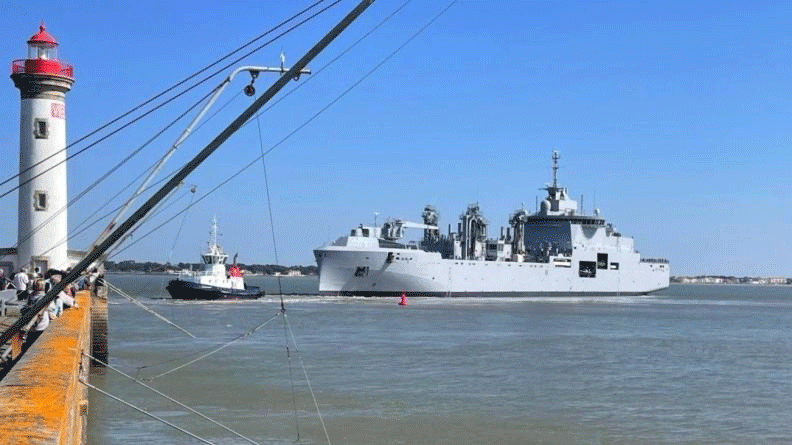The Jacques Stosskopf force replenishment vessel (BRF) began its first sea trials campaign on April 9, 2025, from the port of Saint-Nazaire, with a view to delivery to the French Navy in the summer of 2025.
This building is the second in a series of four that were ordered in 2019 from the temporary consortium of companies (GME) made up of Chantiers de l’Atlantique and Naval Group.
The four BRFs are intended to replace the French Navy’s Durance-class vessels by 2032, with a view to providing support and supply missions for all French Navy vessels: fuel, munitions, spare parts, food, etc.

Essential to the strategic autonomy of the French Navy, these supply ships give France the ability to conduct operations on the high seas and to deploy far and long.
Their cargo and fuel carrying capacities are significantly superior to those of previous-generation vessels. The same is true of their tactical capabilities, with self-defense devices and a combat system allowing them to deploy autonomously to their area of operations and to face asymmetric, surface, and air threats.
Who was Jacques Stosskopf?
Born into an Alsatian family, Jacques Stosskopf was born in Paris on November 27, 1898. A brilliant student, he was drafted into the artillery in 1917 before joining the École Polytechnique in 1920, graduating 23rd in 1922. He subsequently pursued a career as an engineer in the Génie Maritime, a corps specializing in the construction of warships, becoming one of the specialists in the design of destroyers in the 1930s. Present in Lorient in June 1940, he participated in the defense of the city and negotiated with his superiors the retention of French military engineers to supervise the workers at the Arsenal. He played a key role there, gradually gaining the trust of the German authorities thanks to his knowledge of their language and the extent of his technical knowledge. Having become deputy director of the Lorient Arsenal in September 1942, Jacques Stosskopf thus used his influence with the occupiers on several occasions to disguise acts of industrial sabotage as accidents, also succeeding in reducing the number of workers sent for the STO by several hundred. But above all, he took advantage of his freedom of movement to collect a great deal of military information, mainly on U-boats and the submarine base, which he first forwarded to the Allies via the 2nd Naval Bureau in Vichy, then directly via the Alliance Network, of which he became a member in 1942. Denounced, he was arrested on February 24 and finally executed at the Struthof camp in Alsace on September 1, 1944 , with other members of his network.
Technical characteristics
Full load displacement: 31,000 tonnes – Overall length: 194 m – Overall width: 27.60 m – Accommodation: 190 people, including 140 crew members and 50 passengers – Fuel capacity: 13,000 m 3 – Total installed power: 24 MW.
The first BRF, Jacques Chevallier, was delivered to the Navy in July 2023, the Jacques Stosskopf is scheduled for summer 2025, the Emile Bertin in 2029 and finally the Gustave Zédé in 2032.

